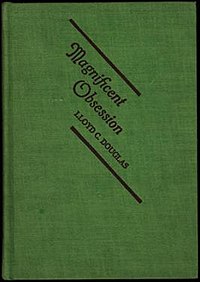Magnificent Obsession: Difference between revisions
changed Category:American novels to Category:20th-century American novels & general fixes using AWB (7916) |
Online book at Project Guttenberg Australia |
||
| Line 58: | Line 58: | ||
*Magnificent Obsession: Frank Lloyd Wright's Buildings in Japan |
*Magnificent Obsession: Frank Lloyd Wright's Buildings in Japan |
||
*Z Channel: Magnificent Obsession |
*Z Channel: Magnificent Obsession |
||
==External links== |
|||
Online Editions: |
|||
*''[http://gutenberg.net.au/ebooks04/0400631h.html Magnificent Obsession]'' available freely at the ''[[Project Gutenberg]] of Australia'' website. |
|||
[[Category:20th-century American novels]] |
[[Category:20th-century American novels]] |
||
Revision as of 10:13, 31 January 2012
 1933 Edition | |
| Author | Lloyd C. Douglas |
|---|---|
| Language | English |
| Genre | Novel |
| Publisher | Willett, Clark & Colby |
Publication date | 1929 |
| Publication place | United States |
| Media type | Print (Hardback & Paperback) |
| ISBN | NA Parameter error in {{ISBNT}}: invalid character |
Magnificent Obsession is a 1929 novel by Lloyd C. Douglas. It was one of four of his books that were eventually made into blockbuster motion pictures, the other three being The Robe, White Banners and The Big Fisherman.
Plot summary
Robert Merrick is resuscitated by a rescue crew after a boating accident. The crew is unable to save the life of Dr. Hudson, a doctor renowned for his ability to help people, on the other side of the lake who was having a heart attack at the same time. Merrick then decides to devote his life to making up for the doctor's, and so he decides to become a physician (specifically a brain surgeon).
In the book
The book's plot portrays Mrs. Hudson, the widow, moving to Europe after Joyce, the doctor's daughter, gets married. Merrick progresses in his career, and in the story's climax, gets involved in a railway accident in which Mrs. Hudson suffers a brain injury. Merrick is instrumental in her recovery.
In the movie
The movie differs from the book in that before deciding to become a surgeon, Merrick not only alienates the doctor's widow, with whom he has fallen in love, but also causes another tragedy. This makes him totally re-evaluate his life, and at that point, he decides to become a doctor.
Inspiration
The story behind the novel, and the identity of the surgeon on whose life it is based, is mentioned in a 2007 article in the American Association of Neurosurgeons' journal AANS Neurosurgeon, "Inspirations and Epiphanies"
The theme of the book is based on a passage from the Gospel of Matthew (chapter 6:1-4):
"Take heed that ye do not your alms before men, to be seen of them: otherwise ye have no reward of your Father which is in heaven.....That thine alms may be in secret: and thy Father which seeth in secret himself shall reward thee openly."
The philosophy behind the book is also partly that of "pay it forward", the idea that good deeds received are not to be paid back to the doer of the deed, but to a needing person in the future.
Dr. Hudson's Secret Journal
Douglas later wrote a book in response to the flood of letters he received from readers who wanted to know where they could find the book to which he referred in the novel, Dr. Hudson's Secret Journal. The Robert Merrick character decoded the journal, from which he learned the secret of his extraordinary success as a doctor. (According to the book, the secret was the literal practice of doing good deeds secretly, and thereby reaping spiritual power to use in becoming an excellent doctor.)
Film, television or theatrical adaptations
- Magnificent Obsession a 1935 film.
- Magnificent Obsession a 1954 film directed by Douglas Sirk.
- Dr. Hudson's Secret Journal a television drama which aired in syndication from 1955 to 1957 (78 episodes).
Other "Magnificent Obsession" uses
- James M.G. Luther Pendragon's progressive-Metal band, James is the guitarist on the project.
- Steven Curtis Chapman has a song called "Magnificent Obsession." It appears in the 2003 WOW Christian Hits album.
- Magnificent Obsession: Frank Lloyd Wright's Buildings in Japan
- Z Channel: Magnificent Obsession
External links
Online Editions:
- Magnificent Obsession available freely at the Project Gutenberg of Australia website.
